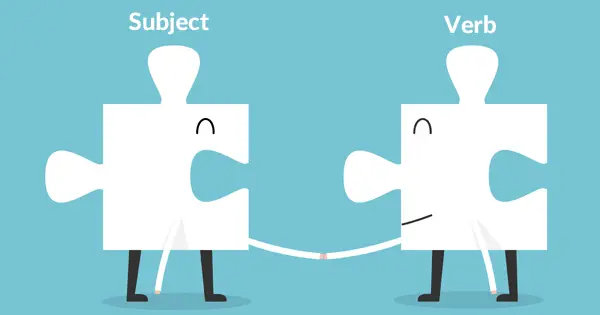If you’re looking for some subject verb agreement activities or games, then you’re most definitely in the right place. We’re going to give you the rundown on the best ones, along with worksheets, lesson plans, online practice, and more.

Subject and Verb Agreement Activities
ESL Subject Verb Agreement Games and Activities
Are you ready? Let’s get to our top picks for subject and verb agreement games that you can try out with your ESL students. But first of all, a quick primer on what is subject/verb agreement.
#1: Concentration Memory Game
If you want to have some fun with subjects and verbs, then you’ll want to try out concentration. It does require some prep, but you can reuse the cards again if you have multiple classes.
The way it works is that you write some matching subjects and verbs on separate cards. For example:
- she
- goes
- they
- don’t like
- I
- am
You’ll want 8 pairs, or 16 in total. Some may match with more than one card which is fine.
Students play in groups of 4 and place the cards face down in an organized fashion. The first students turns over two cards and if they match in terms of subject/verb agreement, they keep them and get a point. Plus, go again. If not, the next person goes. The game continues until all the matches are made.
This is a versatile ESL activity that can be used for just about any sort of grammar point or vocabulary. Find out more about it here: Concentration ESL Matching Game.
This activity also works quite well for auxiliary verbs.
#2 Subject Verb Agreement Classroom Games: Mixed Up Sentences
Students in certain countries struggle more with subject/verb agreement than others due to their first language. For example, in Korean the verb is always at the end of the sentence, so having it at the beginning like in an English sentence can be a bit of a struggle.
That’s why mixed up sentences is a nice activity to work on this. The way it works is that you write a bunch of scrambled up sentences in terms of word order on the whiteboard or PowerPoint. Students have to work to unscramble them and write the correct sentence.
It’s a nice, quick review activity, or can serve as a time-filler or mini-test at the end of class. Find out more about how to do it here: Mixed Up Sentences ESL Grammar Activity.
#3: Proof-Reading and Editing
One of the most common problems that I find in my students’ writing is that they’ve neglected subject verb agreement. When I give them proofreading checklists, this is often the first thing I highlight, and I get them to circle every instance where this occurs.
Even advanced level students can struggle with the nuances of this, especially if the subject and the verb are not next to each other in the sentence. Do you want to find out more about this ESL writing activity? Check it out here: ESL Proofreading Activity.
- Amazon Kindle Edition
- Bolen, Jackie (Author)
- English (Publication Language)
- 112 Pages - 10/24/2019 (Publication Date)
#4: Videos in the ESL Classroom
Do your students get tired of hearing you talk? I know that mine get tired of me! Haha! If that’s the case, then you may want to consider bringing in some videos into your classroom. There are numerous ways you can use them. Here are just a few:
- Use videos to introduce the grammar point (subject/verb agreement) instead of lecturing
- Get students to notice examples of the target language as a quick warm-up
- Use them as a kind of test at the end of class to get students to pick up the target language
- Videos can offer excellent practice opportunities through some fun games and activities.
Learn more about how you might consider using them for teaching this important concept:
How to Use Videos in the ESL Classroom.
#5 Subject Verb Agreement Games: Is that Sentence Correct?
Use this simple warm-up activity to review subject/verb agreements at the beginning of class. Or, as a quick test at the end. The way it works is that you write a bunch of sentences on the whiteboard or PowerPoint. Some have errors, while some do not. In this case, you’d want to focus on subject and verb agreement issues.
Students have to work together in pairs to write the correct sentences. The first team to finish in the winner! Or, you can remove the element of competition and just have students complete the activity.
Do you want to try out this simple ESL activity for yourself? Learn more about it here: Is That Sentence Correct Error Correction Activity.
#6: Dialogue Substitution
Have you noticed that there are often dialogues in almost all ESL/EFL textbooks to introduce the target language? Most students (and teachers too) kind of just breeze through them on their way to more important things. But, it doesn’t have to be this way.
A way to make them more valuable and memorable is to remove some of the words. In this case, it’s either be the verb or the subject. Then, as students are reading it together with a partner, they have to fill in the blanks as well. It turns it from kind of a mindless activity to a far more challenging one. In particular, I like using this activity for irregular verbs.
Do you want to try it out? Learn more here: Dialogue Substitution ESL Activity.
#7: Yes/No Questions
There’s nothing like a good ‘ol yes or no question to see if your students understand subject/verb agreement. For example:
Did you go to school yesterday? Yes I DID
Has she seen the movie yet? No, SHE HASN’T.
As you can see, these kinds of questions are a simple way to review the basics. To see some of my favourites activities that I do with them, check out this list here:
#8 Subject Verb Agreement Activity: Picture Prompt
You can use picture prompt as a kind of test at the end of your class on subject/verb agreement. The way it works is that you find a picture with lots of people doing things. Then, students have to make a certain number of sentences in their notebooks based on it.
For example, students may write the following:
- There are two men in the picture. They are walking and talking together.
- There is one young boy. He is riding his bicycle.
As you can see, there are numerous correct usages of subject verb agreement. As the students are writing their sentences, circulate throughout the class and focus your error correction on this. Learn more here:
Picture Prompt ESL Writing or Speaking Activity.
- Amazon Kindle Edition
- Bolen, Jackie (Author)
- English (Publication Language)
- 68 Pages - 11/12/2019 (Publication Date)
#9: Error Correction Relay Race
This relay race game takes something old (error correction) and makes it new again by adding elements of teamwork and cooperation to it! In this case, you could focus most of the errors on the subject and verb.
Do you want to try it out? Find out more here: Error Correction Relay ESL Game.
#10: Sentence Structure Games
A large part of getting the correct sentence structure is subject/verb agreement. There are a lot of engaging, interesting activities you can use with your ESL students to work on the correct sentence structure. Here are some of our top picks:
Sentence Structure Games and Activities.
#11: Running Dictation
#12: Flashcard Sentences Subject Verb Agreement Activity
In my opinion, flashcards are one of the most under-utilized ESL activities. The way it works with subject and verb agreement is that you can show each student a flashcard. Or, each student can choose one from a face-up pile in the middle of the room.
Then, each student has to make a sentence using a subject and a verb. Some examples:
- (shirt) I am wearing a blue t-shirt.
- (hat) My teacher isn’t wearing a hat.
This activity is obviously better for beginners than it is for more advanced level students!
#13: Disappearing Text Subject Verb Activity
If you teach absolute beginners and have just taught them some basic subject/verb agreements, then you may want to consider using disappearing text as an end-of-class review. Or, you could use it as a warm-up at the beginning of a class to review material previously covered.
The way it works is that you write a sentence on the board. For example:
I am Jackie and he is Tom.
Then have all the students say the sentence out loud. Erase the first word and students can say it again. Eventually students will say the entire sentence but there will be nothing on the board. At the end, you can have students write the sentence in their notebooks from memory (optional).
#14: Sentence Structure Activities
Time spend working on building better sentences with our students will never be time wasted! And of course, a big part of that is subject/verb agreement.
The good news is that sentence structure doesn’t have to tedious and boring. There are a number of things you can do. Check them out here:
Sentence Structure Activities for ESL.
#15: Consider Using the Test-Teach-Test Approach
Unless students are absolute beginners, they likely already know a fair bit about subject/verb agreement. If that’s the case, consider using this approach to focus only on what learners don’t know:
#16: Teaching Subject Verb Agreement Using Eliciting Techniques
Unless you’re teaching absolute beginners, it’s very likely that your students have learned about this before. For example, one of the first grammar concepts that students learn is I am, he is, they are.
It’s for this reason that I often like to introduce this topic by using some eliciting techniques. Start off with the subject and then act confused as to what the correct verb form is! Students will love telling you what it is. Find out more about using this technique in your classes: Eliciting.
#17: Dictogloss Subject Verb Agreement ESL
A nice way to work on this grammar concept is to use this challenging activity, dictogloss. It’s heavy on the listening and it’s also easy to use it as a review for any grammar concept or vocabulary set, including this one.
Find, or write a passage filled with lots of examples or subjects and verbs. The more interesting conjugations the better! Then, read it out at a faster pace than normal for the level of your students. Students have to take some notes and then in pairs, work together to recreate what they heard. After that, read it again and students do the same thing. Finally, they compare what they have with the original reading passage.
Find out more about it: ESL Dictogloss Activity.
#18: Dictation Practice
These days, dictation has fallen out of favor a little bit with the more communicative style approach to language teaching and learning. However, it certainly has some value and I like to use it in my classes once in a while.
In this case, dictate some sentences to the students with various subjects and verbs. Besides reviewing this, it also helps students with spelling, punctuation, and listening skills. Then, check the sentences together as a class.
#19: Chain Spelling
A fun grammar review activity is chain spelling. All the students stand up and you say a subject as well as a base form of a verb. For example: He go.
Then, letter by letter, students have to spell out the conjugated verb form. If someone makes a mistake, they are out and sit down. Continue until only 1-2 people are left standing.
#20: Use an ESL Speaking Lesson
It’s possible to plan a speaking lesson about any topic, or grammar point, including this one. Check out this video for the simple steps that you can follow:
#21: Error Analysis
Provide students with sentences that contain subject-verb agreement errors. Ask them to identify and analyze the errors, explaining why the subject and verb do not agree. This activity promotes critical thinking and a deeper understanding of subject-verb agreement rules.
#22: Story Writing
Ask students to write short stories or paragraphs that incorporate subject-verb agreement correctly. Encourage them to pay attention to the agreement between subjects and verbs throughout their writing. This activity reinforces subject-verb agreement in a creative context.
#23: Subject-Verb Agreement Races
Divide students into teams and provide each team with a list of sentences. One student from each team races to the board, writes the correct verb form based on the subject, and returns to tag the next team member. The team with the most correctly written sentences wins. This activity adds an element of competition and encourages quick thinking and accuracy.
Subject Verb Agreement ESL Worksheets
Do you want to give your students some extra practice with this important English skill? Then you’ll want to check out these ESL subject-verb agreement worksheets:
Subject/Verb Agreement Lesson Plans
Have you noticed that your students in particular struggle with this English grammar point? Then you’ll want to seriously dedicate an entire lesson or two to it. Here are some ready-made subject-verb ESL lesson plans to try out:

Subject and Verb Agreement Worksheets, Games and More.
Subject Verb Agreement Online Games
Finally, do you want to be able to direct your students to some fun online games to practice subjects and verbs online? Here are some of our top picks:
Subject Verb Agreement FAQs
There are a number of common questions that people have about teaching subject and verb agreement. Here are the answers to the most popular ones.
What are the subject verb agreement rules?
The subject-verb agreement rules are as follows. If the subject is singular, then the corresponding verb must be singular as well. However, if the subject is plural, the verb must be as well. If the subject is two or more nouns or pronouns that are connected, use a plural verb.
What is a subject and verb in a sentence?
Simples sentences are groups of words that express a complete thought and which contain both a subject and a verb (predicate). They must agree with other in number (singular or plural). For example, She ate.
What is the subject of a sentence?
Every English sentence must have a subject and a predicate (verb). The subject is the naming part of the sentence or clause and usually appears before the predicate. It shows either what the sentence is about or who or what is performing the action.
What are some common errors in subject-verb agreement made by ESL learners?
Common errors include using a singular verb with a plural subject or vice versa, incorrect agreement with indefinite pronouns, and subject-verb disagreement with compound subjects. Identifying and addressing these common errors can help students improve their subject-verb agreement skills.
Are there any exceptions to subject-verb agreement rules?
Yes, there are some exceptions and special cases that can make subject-verb agreement more challenging. Examples include collective nouns, expressions of quantity, and certain irregular verbs. Teach these exceptions as separate rules and provide practice opportunities to reinforce understanding.
How can I help ESL learners practice subject-verb agreement?
Provide ample opportunities for practice through exercises, worksheets, and interactive activities. Use sentence completion tasks, error correction exercises, and guided writing tasks to reinforce subject-verb agreement skills. Incorporate real-life examples and contextualized activities to make the practice more meaningful.
Can you give some strategies to reinforce subject-verb agreement?
Use visuals and graphic organizers to visually represent the relationship between subjects and verbs. Provide sentence-building activities that require students to select the appropriate verb form based on the subject. Use peer review and collaborative activities to encourage students to identify and correct subject-verb agreement errors in each other’s work.
How can I assess students’ understanding of subject-verb agreement?
Use formative assessments such as quizzes, worksheets, or oral practice sessions to gauge students’ understanding of subject-verb agreement. Assign writing tasks that specifically require correct subject-verb agreement, and provide feedback and correction to help students improve.
Did you Like these Subject Verb Agreement Fun Activities?
- Amazon Kindle Edition
- Smith, Jennifer Booker (Author)
- English (Publication Language)
- 144 Pages - 03/31/2016 (Publication Date)
Yes? Thought so. Then you’re going to love this book over on Amazon: 101 ESL Activities. The key to better English classes is a wide variety of interesting, engaging games and activities and this book will help you do that.
The best part is that the book is well-organized into various sections: speaking and listening, reading and writing, review, 4-skills, and more. You should be able to find what you’re looking for in just a minute or two. If that’s not some ESL teaching awesome, then I’m not sure what is.
You can get the book in both digital and print formats. Keep a copy on the bookshelf in your teacher’s resource room and pull it out when you’re doing your lesson plans. Or, take a copy with you on your phone or tablet to your favorite coffee shop for a serious lesson-planning session on the go.
It really is that easy to have great English classes. Do you want to check out the book for yourself? Head over to Amazon to pick up your copy today:
Have your Say about these Subject Verb Agreement Games and Activities
What are your thoughts about these subject verb activities, games, worksheets, online practice, and lesson plans? Do you have any resources you’d like us to add? Or, have you tried anything from this list? Leave a comment below and let us know. We’d love to hear from you.
Also be sure to give this article a share on Facebook, Pinterest, or Twitter. It’ll help other busy teachers, like yourself find this useful teaching resource.
Last update on 2022-07-17 / Affiliate links / Images from Amazon Product Advertising API







